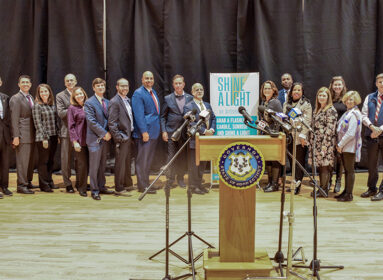By Cindy Mindell

The Jewish High School (JHS) art students from Berlin visited Connecticut for the opening of the “Memories of a Childhood Lost” exhibit in Westport in April 2008. Also on hand were (l to r) JHS art teacher Sabine Thomasius, (two art students), Westport First Selectman Gordon Joseloff, Janet Beasley, and Aubrey Pomerance
of Jewish Museum Berlin.
WESTPORT – Nearly 200 years ago, in 1826, the Jewish community of Berlin, Germany opened a school for boys, moving to a newly constructed building at 27 Grosse Hamburger Strasse in 1862. The school would thrive for 80 years, until the Nazis transformed the site into a deportation center for the city’s Jews from 1942 to 1945. After the war, under East German authority, the building was used as a vocational school.
By 1993, the city’s Jewish population had grown enough to re-establish a Jewish high school. After extensive renovation, the building opened again, this time as the Jewish High School. From 27 students in its inaugural year, the school now boasts nearly 300 students of all faiths, ranging from middle school (grades 5-7) and high school (grades 8-13). The curriculum comprises both Judaic and secular studies, with Jewish holiday observances and kosher lunch regular parts of student life.
This year, on the occasion of its 20th anniversary, the Jewish High School published a book tracing its history. Included among the articles is a story about a special visit to Westport in 2009.
In 2006, Westport resident and German-Jewish Holocaust survivor Janet Beasley donated wartime artifacts, documents, and photos to Jewish Museum Berlin. She was invited by the museum to lead workshops for two groups of German high school students on her experiences as a Jew surviving in Hitler’s Berlin. The first group comprised 13th-grade art students from the Jewish High School, led by teacher Sabine Thomasius.
“Exhibit: A Childhood Lost,” by Thomasius, is translated from the German by Beasley:
In November of 2006, a workshop took place in the Archives of the Jewish Museum Berlin, where students in my art course met with Janet Beasley. Janet grew up in Berlin, the child of a Jewish mother and a non-Jewish father, and as a nine-year-old
[Beasley was actually eight], was deported to Theresienstadt with her mother. The personal memories which Janet Beasley shared with great candor and intimacy led to the creation of paintings and collages during the lessons in the classroom. These were exhibited in the Jewish Community Center Berlin during the summer of 2007.
Janet Beasley was so touched by the students’ pictures that she arranged for an exhibit in her hometown, Westport, Connecticut.
Through this exhibit and reports in the newspapers, many people in her area learned for the first time about the details of this chapter of her life story.
We were invited to the opening of the exhibit in Westport and along with the exhibit opening, we had a tight schedule of meetings arranged and supported by Aubrey Pomerance [chief archivist, Jewish Museum Berlin], Janet Beasley, [Westport artist and German-Jewish Holocaust survivor] Steffi Friedman, and the host families. We had the opportunity to meet with and have lively conversations with students from totally different social spheres as well as with youth groups from a Jewish congregation [Kulanu Stamford]. In particular, the youths in Connecticut wanted to know how Jewish life in Germany is shaped now. The program included conversations with witnesses to history as well as visits to artists in their studios and a trip to New York.
The students’ paintings, depicting incidents from Beasley’s childhood in Berlin and in Theresienstadt, were combined with artists’ statements and copies of the archival materials Beasley donated to the museum, into “Memories of a Childhood Lost,” an exhibit shown at Earthplace in Westport in April 2008.
Janet Beasley’s story is a unique one. She was born Jutta Grybski in Berlin in 1935, the child of Käthe, a Jew, and Hans, a Catholic. Jutta’s parents divorced when she was three, when Hans wanted to serve in the German army. He remarried three years later and had a son.
As long as Hans stayed alive, Jutta, Käthe and Käthe’s parents were safe, though they were rounded up every month or so and taken to Nazi collection centers, only to be released a few hours later or the next day.
In 1941, Jutta’s maternal grandfather, a decorated World War I veteran, was taken to Sachsenhausen concentration camp and shot to death. Two years later, her grandmother died in Auschwitz or on the way there.
In 1944, Hans was killed in action and Jutta and Käthe were taken to Thereisenstadt, where they spent nine months before the camp was liberated. They returned to Berlin and lived with Hans’s father, then emigrated to the Lower East Side of Manhattan in 1946. Jutta changed her name to Janet, partly because Americans didn’t know how to pronounce Jutta, partly because children had taunted her with the nickname “Jutta-Jüde,” “Jutta-Jew.” She moved to Norwalk in 1964 and to Westport in 1973, the same year she returned to Berlin for the first time since emigrating. Her mother died at the Jewish Home for the Elderly in Fairfield in 1992. Janet is married to Dr. Albert Beasley, a longtime Westport pediatrician.
“What is really weird for me is that, when the Nazis closed the school, it became a collection center for Jews before their deportation and my mother and I were sent to the concentration camp from there,” Beasley says. “I had an idea that that was the place but wasn’t sure until I read in the book’s index that it was indeed used for that purpose. It stirred some very vivid memories.”
Comments? email cindym@jewishledger.com.







 Southern New England Jewish Ledger
Southern New England Jewish Ledger













